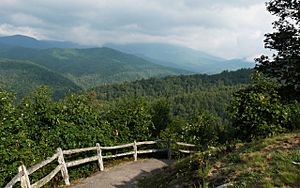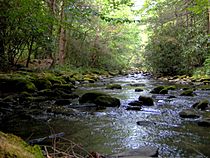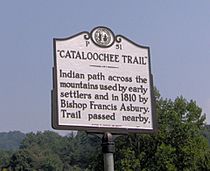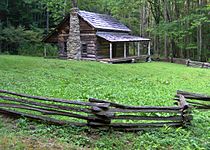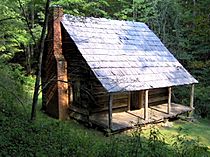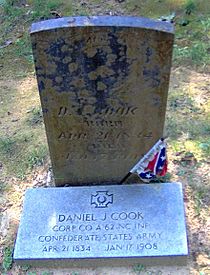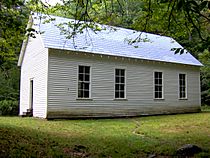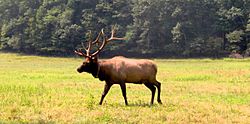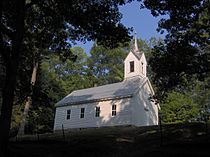Cataloochee (Great Smoky Mountains) facts for kids
Cataloochee is a beautiful valley located in the Great Smoky Mountains of North Carolina, in the southeastern part of the United States. Today, it's a popular spot for recreation and history within the Great Smoky Mountains National Park. But long ago, Cataloochee was a busy community for people living in the Appalachian Mountains. It was also a special hunting ground for the Cherokee people.
Contents
The Land of Cataloochee
Cataloochee is made up of three narrow valleys that run side-by-side. High mountains, called the Balsam Mountains, surround these valleys like walls. To the northwest is Sterling Ridge, and to the southeast is Cataloochee Divide. Both of these ridges are very tall, reaching over 5,000 feet high in many places. To the southwest is Big Cataloochee Mountain, which is 6,155 feet tall!
Two smaller ridges, Noland Mountain and Big Fork Ridge, run between Sterling Ridge and Cataloochee Divide. These smaller ridges split Cataloochee into its three main valleys:
- Little Cataloochee is the northernmost valley. It's located along a stream that shares its name, between Sterling Ridge and Noland Mountain.
- Big Cataloochee is the middle valley. It has rich, flat land along Cataloochee Creek.
- Caldwell Fork is the southernmost valley. It's found between Fork Ridge and the Cataloochee Divide.
All three valleys have streams that flow into the Pigeon River.
A Look Back in Time
The name "Cataloochee" comes from a Cherokee word, Gadalutsi, which means "fringe standing erect." This probably referred to the tall trees that stood like a fringe along the mountain ridges around the valley. The Cherokee people mainly used the valley for hunting. Early settlers even remembered seeing a Cherokee hunting camp near Little Cataloochee Creek.
An important path called the Cataloochee Trail once connected Cherokee towns. This trail was so well-used that it was worn a foot deep in some places. Today, the modern Cove Creek Road follows a similar path.
The Cherokee gave up their claim to Cataloochee in 1791. However, they continued to hunt and fish in the valley for many years. People who lived in Cataloochee later on said their ancestors were friendly with the Cherokee. Some even helped Cherokees who were hiding during the sad time of the Trail of Tears.
First Settlers Arrive
In the early 1800s, settlers started using the open, grassy areas on the mountain ridges around Cataloochee to raise animals like sheep and cattle. The first land purchase was made in 1814. In 1834, James Colwell and his family moved to Cataloochee. Their family name eventually changed to "Caldwell." The Caldwells and the Bennett family settled in Big Cataloochee. Their families stayed there until the 1930s.
George Palmer arrived in Cataloochee in 1838. He settled in the eastern part of Big Cataloochee. The Palmers also stayed in the valley until the national park was created. Jonathan Woody was another important settler who arrived after the Civil War.
Caldwell Fork was likely named after John Caldwell, a grandson of the first settlers. A small community grew around him. Other early settlers in Caldwell Fork included Sol Sutton, Elijah Messer, and Jesse McGee.
In 1854, Jack Vess and Daniel Cook became the first permanent settlers in Little Cataloochee. Daniel Cook's daughter, Rachel, married Will Messer. Will Messer later became one of the wealthiest men in Cataloochee.
Life as a Pioneer
The rich land and good pastures for animals were the main reasons settlers came to Cataloochee. The grassy mountain tops were perfect for sheep and cattle in the summer. Hogs could find plenty of food in the thick forests. Every year, people would take their animals and turkeys to sell them in towns like Waynesville.
Hunting and trapping also helped families earn money. Animal furs were traded for important supplies like salt, coffee, and cloth. Wild animals like bears and panthers were common. One story tells of two women, Mary Ann Caldwell and Allie Bennett, who were cooking fresh pork one night. Panthers smelled the food and tried to get into their cabins! The women had to keep big fires going in their fireplaces to scare the panthers away.
By 1860, Cataloochee had 160 people and was recognized as a township. The Cataloochee Turnpike, the first wagon road in the Smokies, was finished in the early 1860s. It followed the old Cherokee trail.
The Civil War Years
During the American Civil War, many people in Cataloochee supported the Confederacy. Many young men from the valley joined the Confederate army. The valley faced hard times because most able-bodied men left for the war, leaving many fields empty. Cataloochee was raided by soldiers from both sides.
One group of Union soldiers, led by Colonel George W. Kirk, raided many pro-Confederate towns. They found a hospital in Cataloochee where wounded soldiers were recovering and attacked the patients.
Because Cataloochee was so remote, it was also a hiding place for soldiers who had left the army or people who supported the Union. Confederate soldiers often came into the valley to find them. One story tells of Confederate Captain Albert Teague capturing three Union supporters. He made one of them play a fiddle tune before they were executed.
After the war, life was still difficult. Many returning soldiers were too weak to plant crops. The money people had saved was now worthless. When railroads finally arrived in Western North Carolina in the 1870s, it helped the economy recover.
The 1900s in Cataloochee
By 1900, Cataloochee's population had grown to 764 people. The school was too small. In 1906, some community leaders asked for a new, bigger school. When their request was denied, they decided to burn down the old schoolhouse (after removing the furniture!). Then they asked for a new school again, and this time the government had to agree because of laws about school attendance. This new school, called the Beech Grove School, still stands today.
Apples were the main crop sold for money in the early 1900s. The cool climate in the valley was perfect for apple trees. You can still see the foundation of a large building where apples were stored near the Cook Cabin.
By 1920, Cataloochee had two post offices. One was called Ola, after one of Will Messer's daughters. The other was Nellie, named after one of George Palmer's daughters.
In Caldwell Fork, a man known as "Boogerman" Robert Palmer lived in the thick forest. He was very protective of his land and refused to sell trees to logging companies. Because of him, some of the tallest trees in the valley are found along the Boogerman Trail.
Making and selling homemade whiskey was common in the mountains during this time. While most families made it for their own use, some people sold it to earn extra money, especially during the time when alcohol was illegal. This whiskey was sold in Waynesville and even shipped to big cities like New York City.
Cataloochee was mostly saved from the large-scale logging that happened in other parts of the mountains. The national park movement in the 1920s stopped most logging before it reached the valley.
Becoming a National Park
In the 1920s, more tourists came to the Smokies, and people worried about the damage from logging. This led to the idea of creating a national park. To do this, people living within the park's planned borders had to sell their land. In 1928, the residents of Cataloochee learned they would have to sell their homes. Many people were very upset.
However, the Park Commission allowed some residents to stay in their homes for their entire lives. Many people chose this option. But rules about farming and logging eventually made most people move out of Cataloochee by 1943. Most moved to other parts of Haywood County.
In the 1970s, there were plans to make Cataloochee a bigger tourist area, but people opposed it, and the plans were stopped. Even today, former residents and their families still hold reunions in August each year.
Cataloochee Today
Compared to other places in the park, Cataloochee is still a bit remote. While there's a paved road through Big Cataloochee, the main way to get there is by a gravel road called Cove Creek Road. This road has many sharp turns as it crosses the mountains.
The Cataloochee Campground is where Caldwell Fork and Cataloochee Creek meet. There are also campsites deeper in the woods along different trails.
In 2001, the Appalachian Highlands Science Learning Center was built. This center helps scientists study the mountains and helps people learn about their research.
Elk in Cataloochee
Elk used to live in the Southern Appalachian mountains but disappeared due to too much hunting and loss of their homes. In February 2001, 25 elk were brought to Cataloochee from another area. This was a big project, with most of the money coming from the Rocky Mountain Elk Foundation. Now, you can often see herds of elk grazing in Cataloochee, especially in the spring and fall. By 2011, the elk population in the park was estimated to be over 130.
Historic Buildings in Cataloochee
The National Park Service has saved several buildings from Cataloochee's past. Unlike some other historical areas in the park, many of these buildings look more like homes from the early 1900s, showing how life changed over time.
- The Hannah Cabin in Little Cataloochee was built by John Jackson Hannah. Its chimney is one of only three brick chimneys still standing in the national park.
- The Cook Cabin in Little Cataloochee was built by Dan Cook in the 1850s. It was taken apart for safety but later put back together in 1999.
- The Palmer House in Big Cataloochee was built in 1869 by George Lafayette Palmer. It started as a log cabin and was later updated. Today, it's a small museum.
- The Palmer Chapel in Big Cataloochee was built in 1898.
- The Caldwell House in Big Cataloochee was built between 1898 and 1903 by Hiram Caldwell. The Caldwell Barn next to it was built in 1923.
- The Steve Woody House in Big Cataloochee was built in 1880 by Steve Woody. It was originally a log house but was later expanded.
- The Little Cataloochee Baptist Church was built in 1889. It's sometimes called Ola Baptist Church.
- The Messer Barn was built by Will Messer around 1905. It was moved to its current location near the ranger's residence.
Besides these buildings, you can still find old stone walls, chimneys, and cemeteries throughout the Cataloochee valleys.


